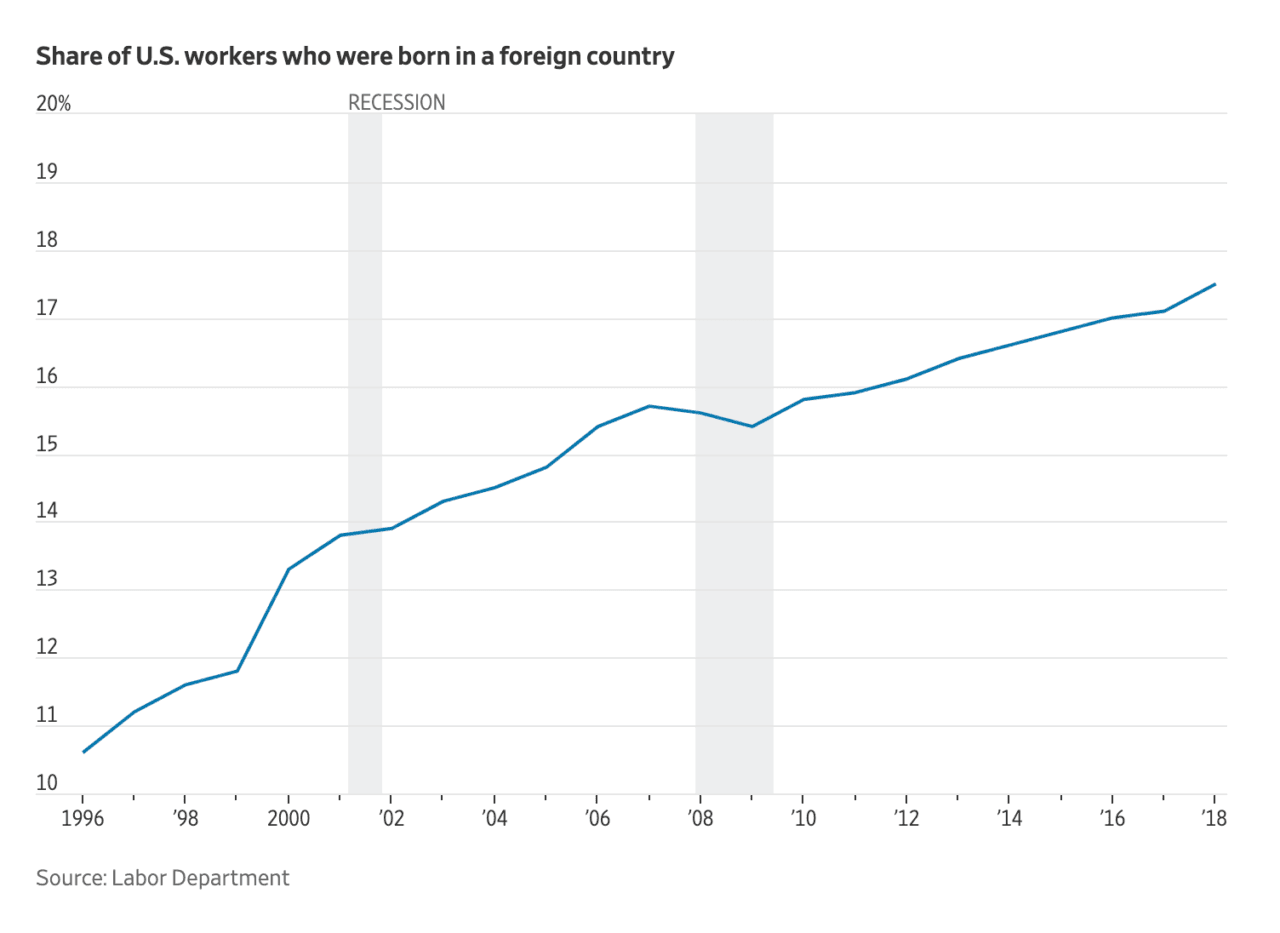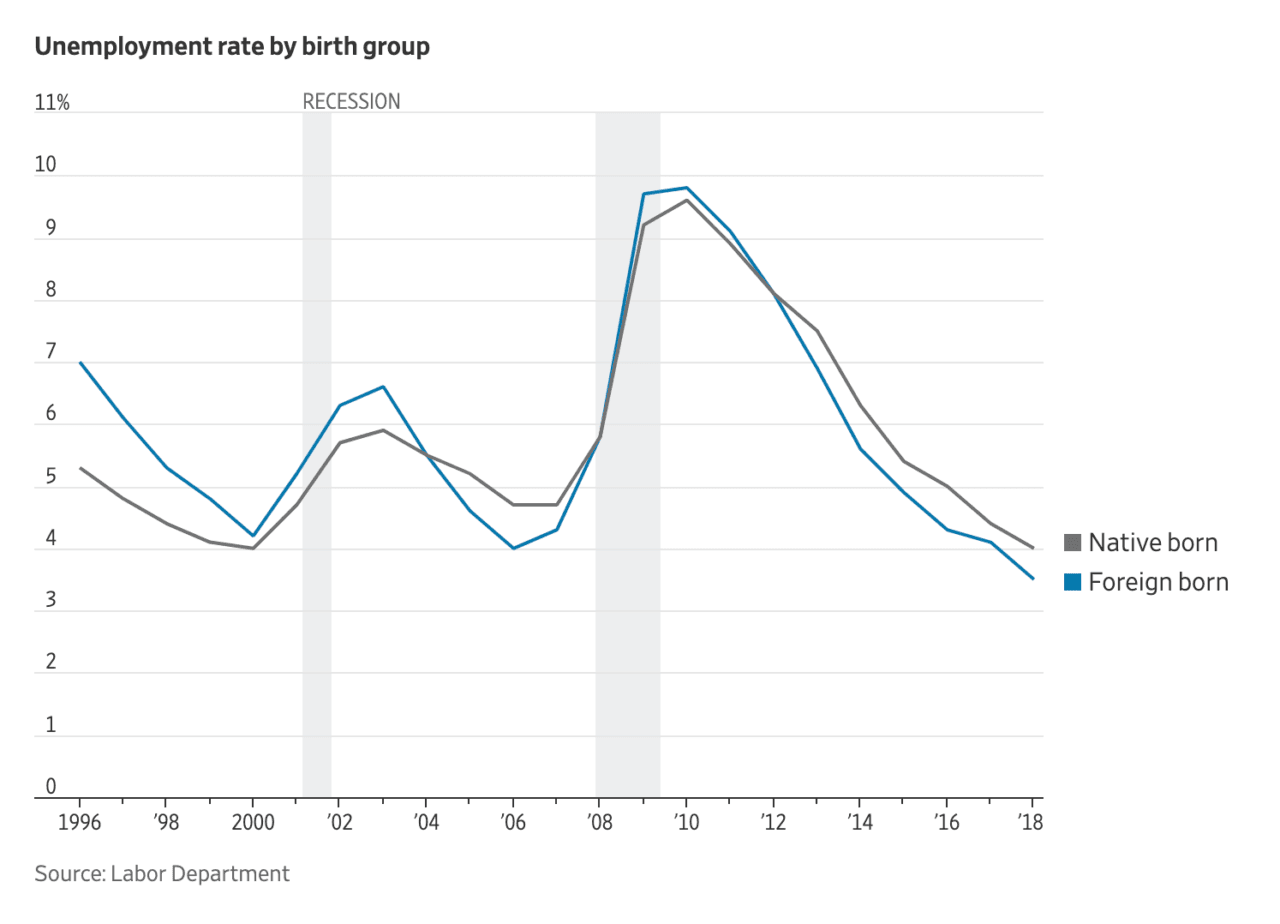The constant flow of legal immigration to the United States — with 1.2 million nationals admitted every year — has driven the “highest level in decades” of foreign-born workers in the American economy, the Wall Street Journal reports.
Foreign-born workers now make up 17.5 percent of the total U.S. workforce, according to the most recent Department of Labor data. This means that about 3-in-17 workers in the American economy were born outside of the U.S., an increase 0.4 percent since last year, when 17.1 percent of all workers were foreign born.
Legal immigration levels, where 1.2 million mostly low-skilled legal immigrants and hundreds of thousands of foreign visa workers are admitted to the country annually, have driven the number of foreign born workers in the U.S. to its highest level since 1996, the Wall Street Journal notes:
There were 27.2 million U.S. workers who were born outside the country last year, up 3.7% from a year earlier. That was an acceleration from 1.8% growth in 2017, and the fastest rate of foreign-born employment growth since 2012. [Emphasis added]
…
“The top overall reason for people to come to the United States is for employment,” said Jeanne Batalova, senior policy analyst at the Migration Policy Institute, a nonpartisan think tank. [Emphasis added]
Foreign-born workers who are Hispanic represent the “largest portion of the foreign-born labor force,” the Wall Street Journal reported, with about 47.7 percent of foreign born workers being Hispanic. Asian foreign born workers represent more than 25 percent of the foreign born labor force.
The data also reveals that compared to native born American workers, foreign-born workers are being increasingly hired by businesses and enjoying less unemployment. This is largely because foreign-born workers are cheaper to hire than native-born Americans, as revealed by Labor Department data.
For example, the average unemployment rate for foreign-born workers was 3.5 percent last year. Compare that to an average unemployment rate of four percent for native-born American workers, as well as the fact that foreign-born workers earn less than native born Americans.
In 2018, foreign-born workers were cheaper to hire for employers, earning a median weekly salary of less than $760. At the same time, native- born American workers’ median weekly salary was $910. The data, though, found that while native-born Americans’ wages have been largely stagnant, foreign-born workers have seen their wages rise.
Though there continue to be nearly 12 million Americans who want a full-time job but are unemployed, underemployed, or out of the labor force entirely, the U.S. has continued admitting more than a million legal immigrants a year to compete for working and middle class jobs against these sidelined. Americans.
Extensive research by economists like George Borjas and analyst Steven Camarota reveals that the country’s current mass legal immigration system burdens U.S. taxpayers and America’s working and middle class while redistributing about $500 billion in wealth every year to major employers and newly arrived immigrants. Similarly, research has revealed how Americans’ wages are crushed by the country’s high immigration levels.
For every one-percent increase in the immigrant portion of American workers’ occupations, their weekly wages are cut by about 0.5 percent, Camarota finds. This means the average native-born American worker today has his weekly wages reduced by perhaps 8.75 percent since 17.5 percent of the workforce is foreign born.
In a state like Florida, where immigrants make up about 25.4 percent of the labor force, American workers have their weekly wages reduced by about 12.5 percent. In California, where immigrants make up 34 percent of the labor force, American workers’ weekly wages are reduced by potentially 17 percent.
Likewise, every one-percent increase in the immigrant portion of low-skilled U.S. occupations reduces wages by about 0.8 percent. Should 15 percent of low-skilled jobs be held by foreign-born workers, it would reduce the wages of native-born American workers by perhaps 12 percent.
At current legal immigration rates, about one-in-six U.S. residents will have been born outside of the country by 2060, the Census Bureau has found. The foreign-born population in the U.S. is expected to reach 69 million in the next four decades.
John Binder is a reporter for Breitbart News. Follow him on Twitter at @JxhnBinder.



COMMENTS
Please let us know if you're having issues with commenting.